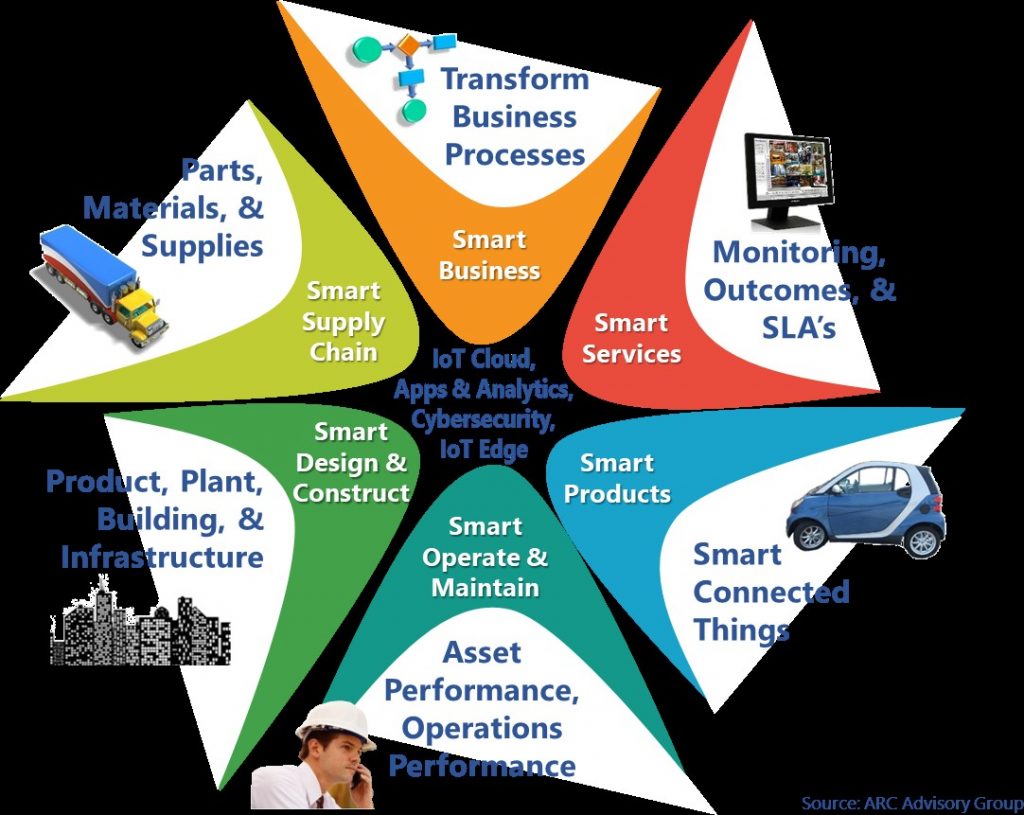In a world increasingly characterized by digital economies and disruption, every market disturbance exponentially widens the business agility gap between the less digitally evolved and those companies that have demonstrated innovation leadership through digital transformation. For those that are not transforming with urgency, the negative consequences will become compounded to the point of being untenable.
Analytics and the Industrial IoT (Internet of Things) are cornerstone competencies for digital transformation, and industrial innovators are harnessing them to accelerate their competitive differentiation. However, for many industrial companies, scalability challenges with these competencies are still limiting broader adoption, particularly by operational users. Most of the issues are organizational and cultural, though they are often viewed as technological challenges, put forward as limitations around data management, lack of skill sets and work cohesion, unexpected cost and desire to avoid software-driven organizational upheaval.
Given that industrial digital transformation is so necessary to remain viable and competitive, why are mistakes, false starts, and dead-end investments with analytics and Industrial IoT all too common? How is it that innovation leaders avoid these challenges? This post will outline where and why many companies go off track when thinking about digital transformation strategies, with a focus on analytics and Industrial IoT. Additionally, it will highlight the six key characteristics innovators embody that allow them to sidestep these challenges. Finally, the post will present a starting point for how to begin to effectively implement digital transformation using analytics and Industrial IoT.
Mistaking digital transformation as a technology pursuit
Although monumental resources and investment have been applied to digital transformation, the effort has not equaled success. Data is still hard to access, organize and use. Leaders struggle to understand how to connect strategy to execution. Workforce and organizational culture barriers remain. Return on investment is difficult to demonstrate, leading to an endless cycle of vendor testing. Where investments are made, use cases often don’t scale as anticipated. These issues are compounded by the realization that what works for one use case often doesn’t translate to others that seem similar on the surface.

As demonstrated in Figure 1 above, digital transformation presents many possibilities and starting points – plant floor, supply chain, engineering, smart services and products, etc. The opportunities often require a range of disruption to traditional ways of operating, from the potential for massive revamping of business and work processes to completely new models for customer engagement.
Making sense of these myriad opportunities requires some means to filter decision making on which path(s) to take, why, and in what order. As organizations contemplate the breadth of these opportunities, a natural line of thinking arises: a technology or set of technologies (e.g., platform) can be identified and purchased to drive all or most aspects of change.
As a result, conversations become technology-centric. Digital transformation turns into the pursuit of the silver-bullet solution or a proof-of-concept of the latest-and-greatest technology. Striving to get a potentially high-risk decision right, organizations look to compare solution techniques, tools and technology architectures in “apples-to-apples” ways, even when that’s not possible.
Six characteristics of digital transformation leaders
Companies that get stuck in a technology-centric view of digital transformation simply don’t succeed. Without better ideas on how to develop strong digital competencies, what ARC refers to as “digital wisdom,” they often experience collapse of their pilots and projects, leading to the internal perception of wasted investment. With analytics in particular, companies are now experiencing scalability challenges that are limiting widespread use of data as a business asset.
Leaders in digital transformation are committed to succeeding, despite the learning curve. As a result, they have been at it for a few years now, understanding that they need to learn and accrue digital wisdom. That wisdom has translated into a digital backbone — of a culture comfortable with digital-first thinking — that their competitors simply don’t have. These leaders can be distinguished by six key characteristics they demonstrate when approaching industrial innovation via digital transformation:
1. Focus on external market signals
Innovation leaders ask different questions, and they begin with external market signals, whether specific to customers, competitors, or some market factor. Digital transformation does not occur unless it supports competitive differentiation relative to those signals.
2. Emphasis on differentiation
As business processes become digital, a company’s responsiveness is its differentiating value. That speed and accuracy of how a company recognizes and reacts to external market signals using its unique expertise is how companies will differentiate in digital economies. The loose phrase, “business agility” is often used to describe this new way of achieving competitive excellence.
3. Commitment to change
Once a leading company understands what it is trying to affect and the competitive value of it, it becomes much easier for leadership at multiple levels to establish a vision for that business improvement and also identify how it should occur.
4. Transparency of objectives
These leading companies also understand that their people, those experts critical to their intellectual property and competitive advantage, need to know how they are valued as part of transformation. Armed with an externally-based vision for change, leadership can be transparent by communicating what transformation will look like and how it will affect people.
5. Aligned incentives
As is widely understood, most people act upon what they are incented to do. With digital transformation, leading companies are asking individuals, work groups, business units, and even entire organizations to consider doing things in new ways and changing continually. By realigning incentives away from more traditional thinking that assumes change is risk to ones that are transformation-centric, these leading organizations are able to better reward transformative behavior. In doing so, these innovators demonstrate that continual improvement is both the new norm and something that is positively incented.
6. Strong digital peer groups
A theme running through all five of the points above is that leading companies recognize they don’t have all the answers. After all, if they or their traditional ecosystem did, they’d be transformed by now. Because of this, they are open to aggressively expanding their sources of wisdom beyond their historic and current resources.
Transformation is an outcome of experimentation, and speed comes as wisdom is accrued. It is important to reiterate that leaders in digital transformation don’t arrive at success overnight. However, because they have a clear vision of the value of the outcomes needed, they spend time and resources learning how to do transformation well and (eventually) quickly.
Starting point: From signals to differentiation
For most companies, and this goes for innovators when they started, it is typically overwhelming to determine an effective starting point. ARC recommends identifying an external signal to your company, products and markets. Rather than jumping right into an initiative that can be too disruptive to manage, that market signal can first be framed in terms of capacity to change. Simply put, does the company have the capacity to change how it needs to? Where are the limiting capability gaps?
To answer these questions, assess organizational makeup and capabilities for transforming. This means candidly examining (and, perhaps, confronting):
- People and culture: Review the organization’s culture of innovation/change, including its ability to engage customers in new ways. The assessment should incorporate human capabilities, resources, and skills available for change and how worker performance is Does the organization have the talent in place to drive transformation?
- Analytics data and technology: This covers the technology, methods and processes necessary to deploy, use and scale analytics and Industrial IoT. It should examine the organization’s ability to implement the necessary governance changes inherent in the broader, more democratized use of data. Ultimately, how prepared is the company to use data as an asset?
- Operational infrastructure: This entails the virtual/physical asset environment within the organization across its operational footprint. It also encapsulates the lifecycle management of critical assets as well as the cybersecurity of the related data. Can these assets align performance to support potentially new ways of serving customers?
With competitive differentiation as the end goal, the assessment helps the organization first determine whether it has the technological, cultural and skillset fundamentals needed to achieve it via digital transformation. As such, it is an ideal starting point for companies looking to begin the digital transformation journey or those stuck in a cycle of poorly scaling pilots.
To learn more, watch the on-demand webinar featuring experts from SAS and ARC Advisory Group, Modernizing Manufacturing: Why Digital Innovation Is Critical Now.
Note: ARC Insights are published and copyrighted by ARC Advisory Group. The information is proprietary to ARC and no part may be reproduced without prior permission from ARC.

